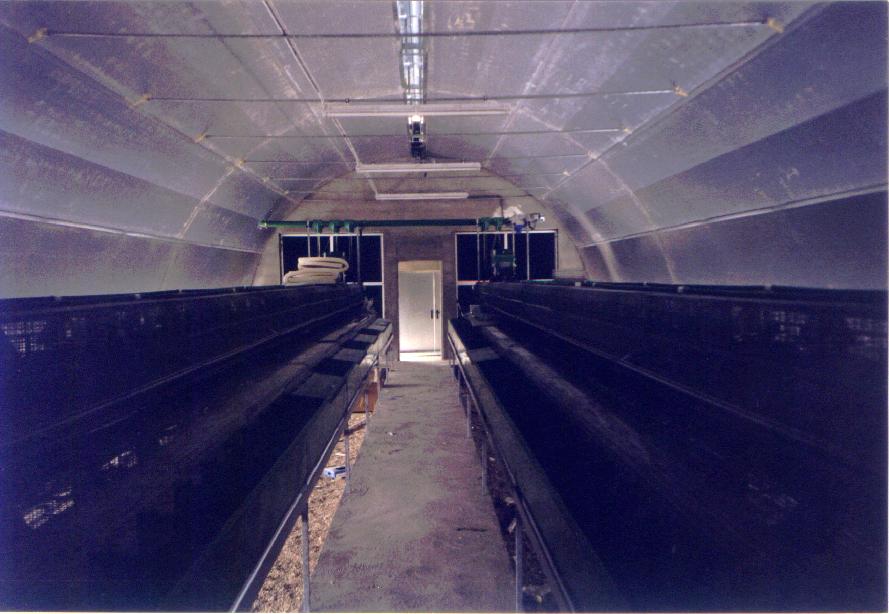Given its importance, we transcribe the following article published on this page:
Source: https://avicultura.info/ventilacion-tunel-vs-ventilacion-transversal/
Written by Serafín García Freire (aviNews España)
The most suitable ventilation design, as well as the number of extractors, square meters of panel or nozzles and air intakes necessary, will depend fundamentally on the climatology of the place where our ship is located, although the final weight of the vessels must also be taken into account. birds.
In intensive poultry farming, there are basically two possible ventilation designs under thermal stress conditions:
Transverse Ventilation
Tunnel Ventilation
Transverse Ventilation
The air moves through the action of fans, transversely to the side facades of the ship, either entering through one and going out the other, or entering and exiting through the same facade.
In times of high temperatures, we will not have the resource of air velocity to reduce the thermal sensation of birds (Bustamante et al., 2013). Cross ventilation is recommended in regions where summers are very mild (for example with maximum temperatures of 25 ºC).
In transverse ventilation, the average values of the air velocity at the level of the birds, even with all the fans working, will not exceed 0.6 m / s.
Tunnel Ventilation
In the tunnel ventilation all the air enters through some gates located at one end of the ship, circulates along it and exits through the extractors located at the other end. For the lateral facades neither enters nor leaves any air, the ship behaves like a tunnel – hence its name.
With tunnel ventilation we will achieve air speeds of up to 2.5-3 meters per second in a homogeneous way. At these speeds, the birds increase the dissipation of heat, which generates a body cooling that makes the perceived temperature is lower than that marked by the thermometer. In this way we can use, gradually, the air speed to relieve thermal stress.
When the cooling produced by the air velocity is not enough, evaporative cooling will be started by means of panels or nozzles located at the end of the ship through which the air enters. In this way we get the sum of the two cooling -reduction of the thermal sensation by air velocity plus the reduction of the air temperature by evaporation of water-.
Advantages of tunnel ventilation in conditions of thermal stress
In transverse ventilation rooms, the interior temperature may not be high enough to allow the initiation of evaporative cooling in adult chickens (28ºC). Remember that birds from 22ºC drastically reduce daily weight gain (Graph 2 ).
* 60% relative humidity, feeding fulfilling the requirements of NRC (1994) and in birds between 28-42 days of life
“Tunnel ventilation allows birds to cool during the pre-cooling period and progressively”
When the outside humidity is high – feeling of heat – the evaporative cooling is not able to evaporate enough water and therefore does not sufficiently lower the temperature of the incoming air. In these conditions, the air velocity of the tunnel ventilation complements the low efficiency of the evaporative cooling
The cooling provided by the tunnel ventilation allows to reduce the time of use of the evaporative cooling and we will have less problems of wet beds (less pododermatitis). This ventilation provides an extra safety system in the event of failure of evaporative cooling such as: failure of the pressure pump -especially serious in the nozzle system-, rupture of the water circuit of the evaporative system, depletion of the well water, etc.
The external humidity is normally high in coastal areas but also in inland areas, at specific moments, after the discharge of a storm.
In most of the Iberian Peninsula the use of tunnel ventilation combined with evaporative cooling is highly recommended. In places where there are maximum average temperatures above 25ºC, tunnel ventilation also allows the body to cool down. Currently in Spain most of the poultry houses of new construction already use tunnel ventilation, so that little by little they are already overcome reluctance or false myths as tunnel ventilation generates “colds”, that the birds “fall and they do not eat “or that it is a very novel system that is not yet proven. The use of tunnel ventilation has been widespread for decades throughout the world.
For more information, do not hesitate to contact Control y Ventilación, S.L. manufacturer of cooling towers NUCLEOS, and evaporative cooling, HUMIBAT, using in both lines as filler and separator of drops of high efficiency, el PANAL C&V and SEPARADOR C&V, both made of high density polyethylene, flexible plastic easy to clean and maintenance , as well as easy replacement, and with high maximized and constant yields.
www.controlyventilacion.com/refrigeracion-evaporativa/
www.controlyventilacion.com/relleno-y-separador/


Recent Comments